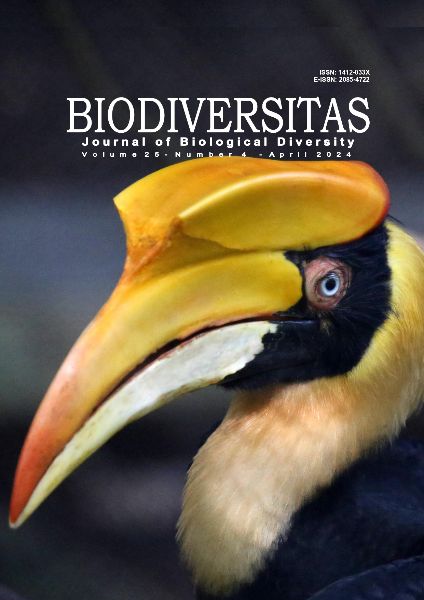Exploration and characterization of indigenous Trichoderma spp. as antagonist of Rhizoctonia solani and plant growth promoter of maize
##plugins.themes.bootstrap3.article.main##
Abstract
Abstract. Iswati R, Aini LQ, Soemarno, Abadi AL. 2024. Exploration and characterization of indigenous Trichoderma spp. as antagonist of Rhizoctonia solani and plant growth promoter of maize. Biodiversitas 25: 1375-1385. Maize sheath blight disease, caused by Rhizoctonia solani, is the main maize disease in Gorontalo and is widespread from the lowlands to the highlands. The indigenous Trichoderma spp. is known to function as a biocontrol agent while producing secondary metabolites that promote plant growth. The objective of this study was to isolate, select, and identify indigenous Trichoderma strains that act as antagonistic agents and promote maize plants growth. The bulk of the soil samples were collected from the rhizosphere of maize plantations in the lowland (0-300 masl), medium (300-500 masl), and highland (500-1000 masl) regions at several sites in Gorontalo. Trichoderma spp. isolation was carried out using the serial dilution method on Rose Bengal chloramphenicol medium, and the strains were further purified in PDA medium, followed by morphological and molecular identification. The antagonistic effect was assessed using dual culture method. In addition, the plant growth-promoting traits examined were qualitative IAA production, potassium solubilization, phosphate solubilization, and in vivo for maize plant growth promotion. Molecular identification revealed that the indigenous fungal strains were dominated by three species, namely, Trichoderma asperellum, T. virens, and T. brevicompactum. Other strains identified were T. ghanense, T. reesei, and T. dorothopsis. Of the 30 Trichoderma spp. strains, 25 inhibited R. solani more than 50%. All Trichoderma spp. strains can produce IAA qualitatively and dissolve phosphate at different intensities; only one fungal strain namely T. dorothopsis-TZ31LU1, can solubilize potassium. In addition, several indigenous Trichoderma spp. strains were able to increase the growth of maize plants in vivo. Thus, 25 Trichoderma spp. strains had the potential to be developed as biological control agents for maize sheath blight disease as well as plant growth promoters in maize.

